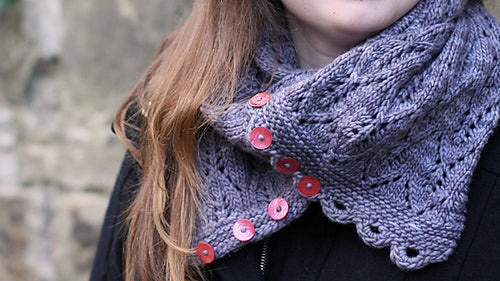Patterns
Notions
Gifts
Stitches: One | Lace
June 01, 2015 6 min read
I am very excited to announce a new Tangled Yarn blog series: Stitches.
Over the next few months we will be taking an in depth look at knitting stitches. Each blog post will include hints and tips to help you get the most from your knitting and will be jam packed with inspiring designs and yarns to get your needles clicking.
Stitches: One | Lace (part 1)
Lace, the glorious knitted fabric filled with intentional holes – that is the beauty of this exquisite stitch. The process of combining yarn overs, to create the holes, with decreases, to provide shape and structure, is the essence of lace knitting. This, often daunting, style of knitting really consists of just a few elements that are combined into an almost infinite number of possibilities, creating stunning motifs to adorn your knitting.
As with all styles of knitting lace comes in all shapes and sizes, from the easiest eyelet patterns to the most elaborate and complex lace shawls. While it can often seem a little intimidating for a new lace knitter, there are plenty of great beginner patterns out there. The hints and tips in this blog will also set you off on the right foot.
What do I need to get started?
To help guide you in picking the best materials for the job I have included some useful hints and tips below. Always remember though, gathering your favourite needles, some beautiful yarn that you love and a pattern that makes your heart sing is the best first step. I am a firm believer that working with the things we love makes us happier knitters.
Choosing needles
- Look for needles with a nice sharp point. This makes it easier to form the stitches needed to create those beautiful lace motifs.
- Opt for circular needles even though you are knitting flat. The extra space helps to hold all the stitches.
- Ideally you want circular needles where the join is smooth and sleek; you don’t want your yarn catching on the join.
Always check what the designer recommends, but remember that typically for lace knitting the needle selected should be larger than the needle typically recommended for that yarn weight. Usually it is between two and four sizes bigger than recommended. For example DK usually knits on a 4mm, lace would probably be knitted on 6mm – 8mm, depending on the project. Remember it is crucial to swatch and make sure you get gauge for any pattern you are working on and a fabric that you love.
Choosing yarn for lace
You can knit lace with anything your heart desires, however you will get the best results if you follow some simple guidelines.
- You want something that blocks well and drapes well. Wool is the number one candidate for this. Wool blended with other fibres for added sheen and drape, such as silk, are real gems for lace knitting – especially shawls.
- A smooth yarn that shows off your stitches is generally going to be better than a fuzzy yarn with lots of halo. For your first lace projects I would steer clear of mohair and alpaca as the halo can obscure the stitches and it makes it much harder to read your knitting – a crucial skill in lace work.
- When choosing colours try to pick something that will let the delicate lace stitches take centre stage. I would usually advise steering clear of high contrasting variegated yarn
Accessories and helpful, but optional, extras
Stitch markers are your friends!
When you are first starting out you want lots of stitch markers; choose ones that are lightweight and it also helps to have different colours on hand. Lockable stitch markers are also useful for catching dropped stitches.
Blocking mats and wires.
These really are optional accessories for blocking, but you will certainly find them useful if you knit a lot of lace. When you are first starting out some pins and a towel will do though.
Want to know more about blocking? Pop over and read this article about the benefits and process of blocking knitwear.
Lifelines …
Smooth crochet cotton and blunt tapestry needle. This is perfect for creating “lifelines” – the special “safety net” inserted into lace knitting, making it easier rip back your work if you make a mistake that can’t be easily fixed.
To insert a lifeline you carefully run the cotton (or yarn chosen for the lifeline) through the stitches on the needles, making sure you catch every single stitch. I tend to leave a very long tail on the lifeline and then tie it loosely in a bow so it can’t be accidentally pulled out.
I would advise putting a lifeline after every repeat when you are first starting out, and after major sections in larger projects. Over time you will develop a feel for where you need lifelines the most. Go with your instinct on this one.
Charts
No discussion about lace knitting would be complete without a chat about charts. These are the visual tools that knitters use to follow complex lace patterns. They consist of a number of (reasonably standard) symbols, presented in a grid style.
Charts are read from the bottom to the top. For work in the round charts are always read from right to left, as all rows are right side rows. For flat knitting charts are read from right to left for right side rows and then back from left to right for wrong side rows.
The Vaila pattern below and the tutorial by Tin Can Knits for the Gothic Lace Cowl both have detailed information about using charts.
Ready to get started?
I have picked three great starter lace projects. They are all for heavier weights of yarn, perfect for knitters new to lace and contain lots of helpful hints and tips in the pattern.
Vaila by Clare Devine is an easy lace shawl designed for knitters wanting to learn to knit lace and read charts. It is perfect for any weight as it uses a percentage system. The lace is charted and written, with lots of helpful tips on chart reading included in the pattern. The pattern is free to Tangled Yarn readers until June 14th, using the code Tangledlace.

Yarn ideas: This shawl will work in any weight but if you are just starting out you may find it easier to knit with sport or DK. Malabrigo Arroyo (100g would give a lovely size shawl and be a great starter project)
Nurturing Fibres Supertwist DK (100g – 200g recommended, depending on the size you are aiming for)
Gothic Lace Cowl by Tin Can Knits is an ideal pattern designed for those new to lace knitting. The pattern is free and there is an in-depth tutorial on the Tin Can Knits blog to help you along the way.

Yarn ideas: Manos Maxima and Rosy Green Big Merino Hug would be excellent choices for this great pattern.
Modular blankets also make brilliant projects for developing your lace skills. With the added benefit that they are perfect for knitting in warmer weather, small pieces that you sew up at the end (after all you don’t want a huge blanket on your lap all summer).
The Vivid Blanket by Tin Can Knits offer a wonderful canvas for playing with colour, all three yarns suggested have spectacular colour ranges, let your imagination run wild.

The pattern can be knitted up in a variety of weights if you are very new to lace knitting you may be better with something a little thicker.
Opt for a slightly lighter weight blanket in Blacker Swan 4ply
A mid-weight blanket would be delightful in the Rosy Green Cheeky Merino Joy
About the Author
 Clare Devine is a writer and designer. Originally from South Africa, she has nomadic tendencies and is currently knitting her way around the UK. She is passionate about all things fibre related (especially if it’s grey), knitting, travel and sunshine in equal measures.
Clare Devine is a writer and designer. Originally from South Africa, she has nomadic tendencies and is currently knitting her way around the UK. She is passionate about all things fibre related (especially if it’s grey), knitting, travel and sunshine in equal measures.
She regularly blogs at knitsharelove.com. You can find her on Ravelry as Knitsforklipskaap, Twitter as @KnitShareLove and Instagram as @knitsharelove
Recent Articles
Subscribe
Sign up to get the latest on sales, new releases and more …




